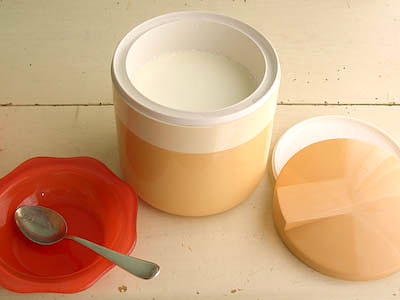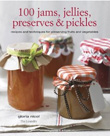
2010 was the year I learnt about canning, or bottling, or hot water processing stuff in jars, whatever you want to call it. Following the year through ingredients, working with the seasons and the produce that was close to hand, has given me a real feeling of connection to the food that I eat and has changed my life and my approach to preserving. Not only that, I’ve got a cupboard full of food in jars, a sort of mini pantry, as my house is too small to include a special room or larder. Granted, most people don’t have shelves of bottled comestibles in their sitting room or lined up on the sideboard! See my friend Tigress’s recent post about her pantry ( the Domestic Goddess is sooo last century, now chatelaine in the buzz word!) and Dana and Joel’s great wall of preserves, in their city apartment. So you see it isn’t necessarily about having a special room in your house or living in the country.
*From now on I am going to refer to the bottling and preservation of ingredients using a hot water bath process as ‘canning’. You’ve been told. I know that in the UK this causes some confusion as the assumption is that this infers putting food in tin cans, but I am talking about preserving food in glass jars. OK have we got that straight now?
The biggest surprise for me has been how amazing the flavours of canned food can be. I grew up thinking that only fresh was best and that bottled, tinned and stored foods were second rate and down market. What I have learnt during my first canning year has totally blown that notion out of the water.
Now the year has swung full circle and there is a feeling of beginning again, its time to take store and note the successes – the rhubarb ketchup, black grape chilli jam and lemon fig & lavender marmalade I want to always keep a stock of. But more importantly I want to plan my goals for the year ahead. Plant blueberry bushes on the allotment to produce enough fruit to preserve, thus bypassing those ridiculously expensive and tweeny-weeny cartons you get in the supermarket, and too plant an asparagus bed so that a few years hence I will be able to harvest my own crop.
It is about pacing things, their needs to be a correlation between the amount of food stored and the rate it is consumed. There will always be some experimentation going on, but as well as enjoying the satisfaction of a well stocked cupboard I love the moment the spoon scrapes the bottom of the jar, each empty jar offering the opportunity to be filled anew. In the year ahead I will be using my preserved foods as ingredients for baking and to include as part of other delicious meals.

As well as jams and chutneys, I’ve got cordials, compotes and fruit purees and pickles stacked on my shelves. Today for lunch I popped open a jar of salted caramel pear butter and another of squashed Blaisdon plums. A dollop of each plus some homemade yogurt (and a tiny sprinkling of hazelnut praline on the top just to be flash) made a really delicious snack. The important thing about these preserves is that they aren’t laden with sugar in the same way that jam usually is. This is why canning makes such sense.
Sorry! This post was supposed to be about making homemade yogurt, but it has changed into something else. I’ll do the yogurt thing later as it seems a strange diversion to go there now and I’ve got other things I need to get on with. Anyone picking this up by Googling will be well annoyed.





